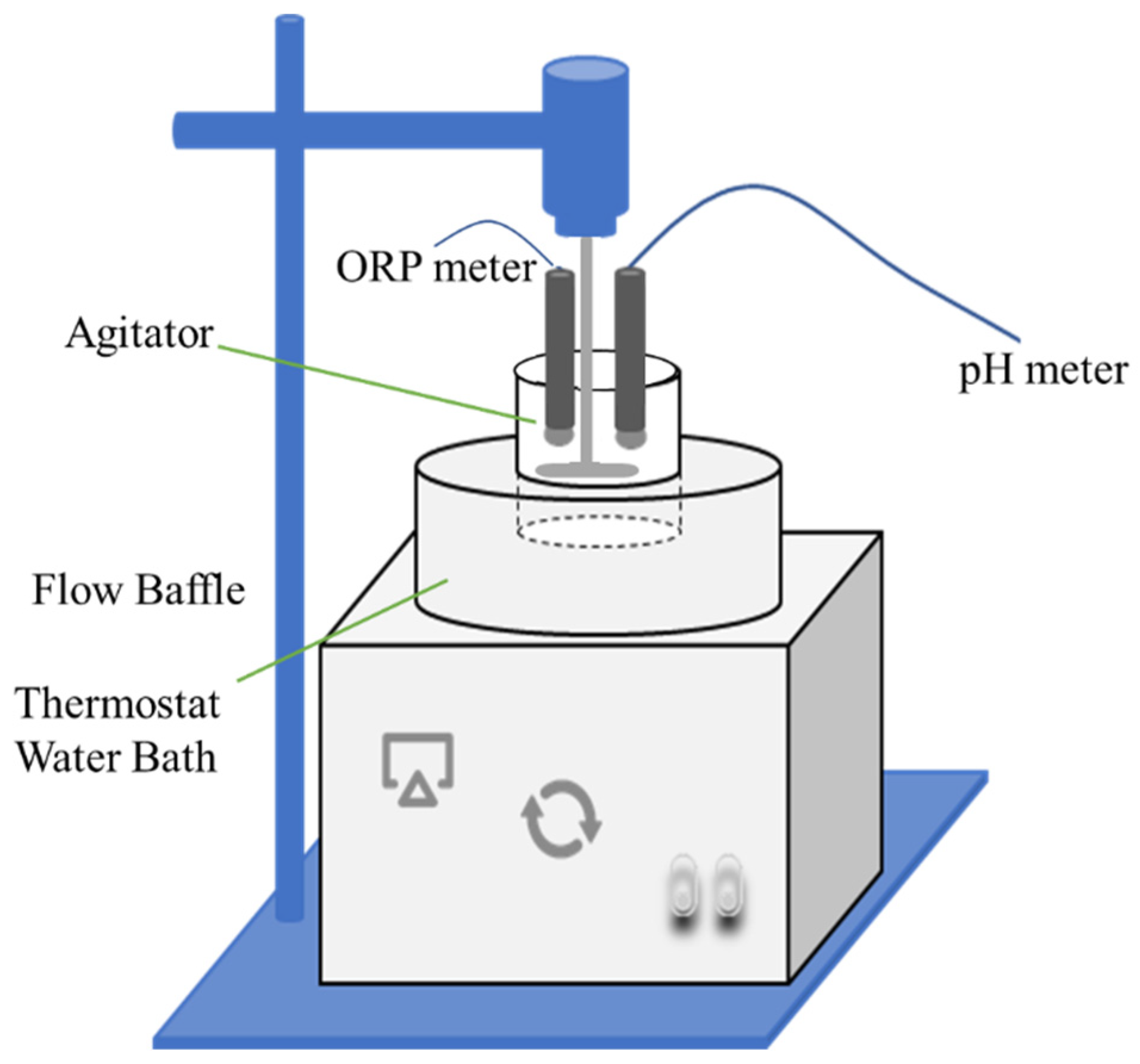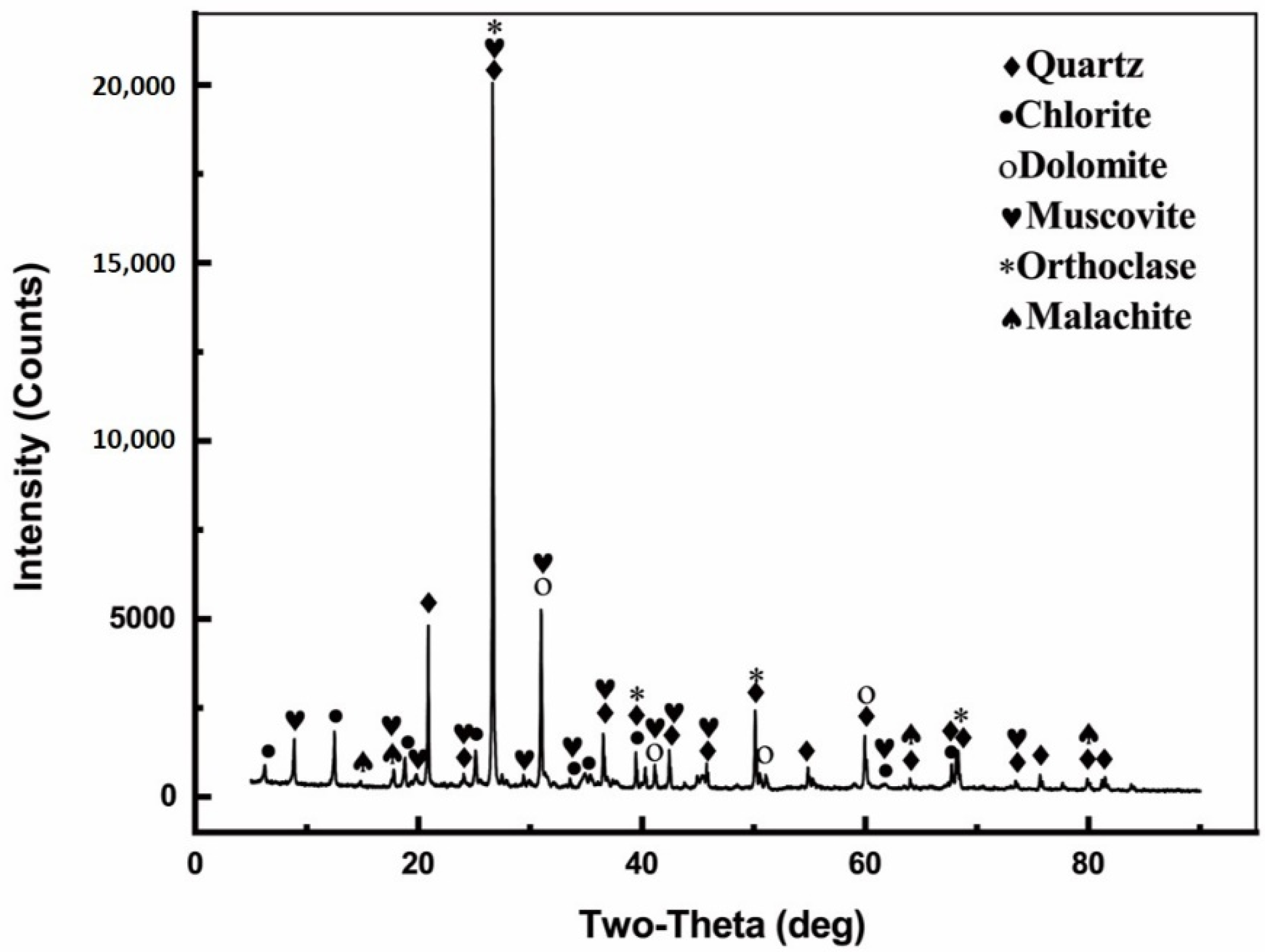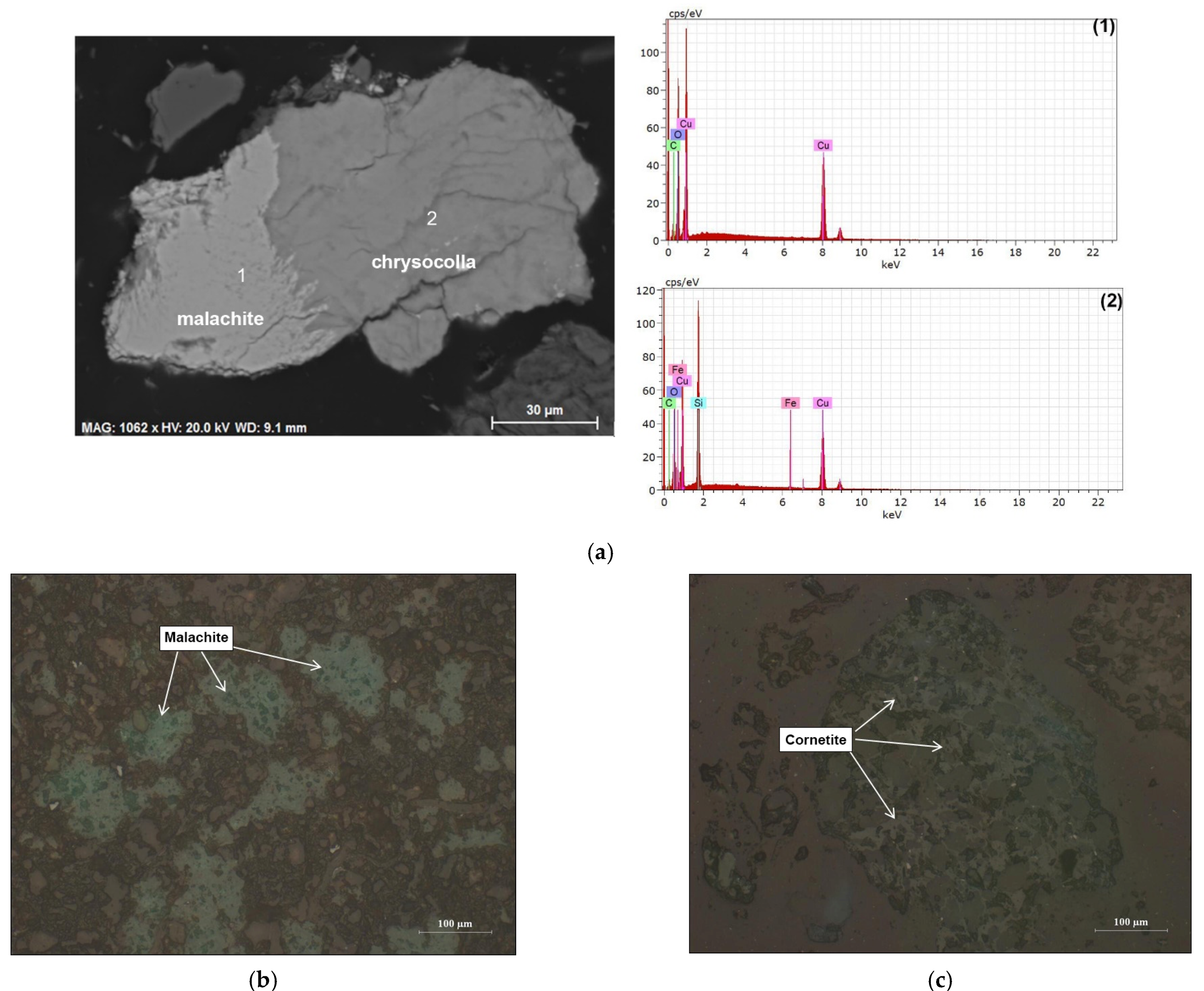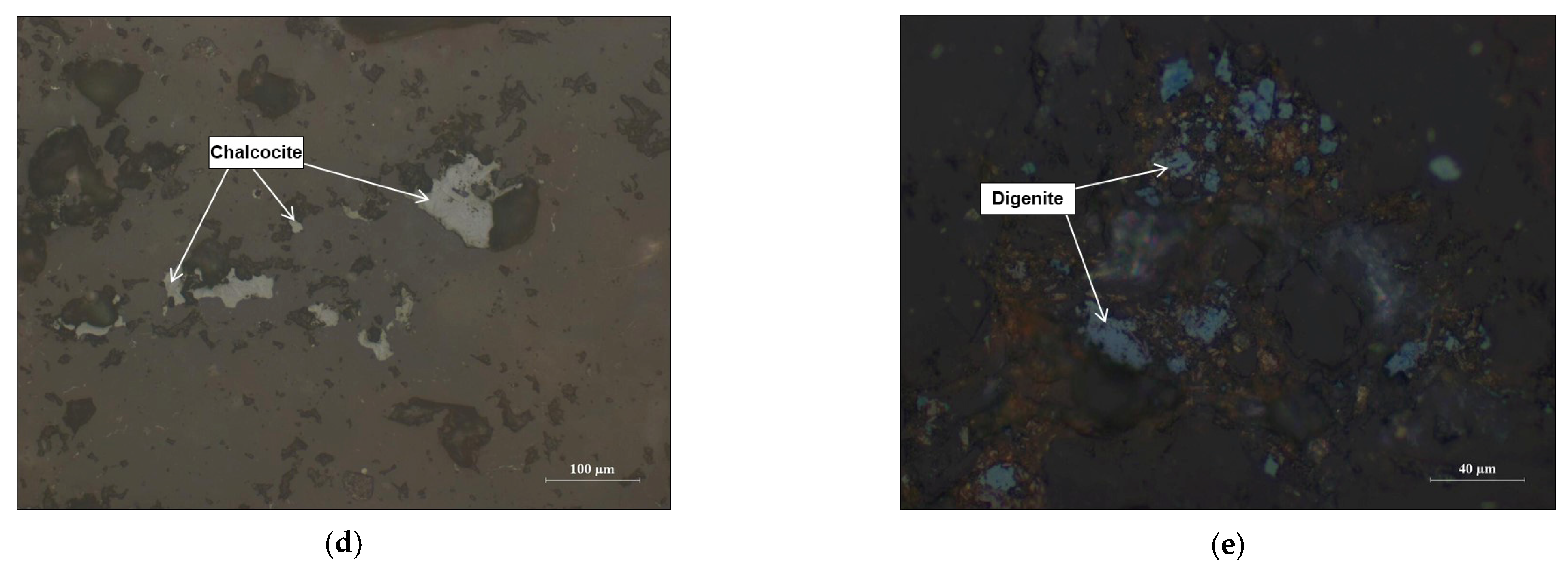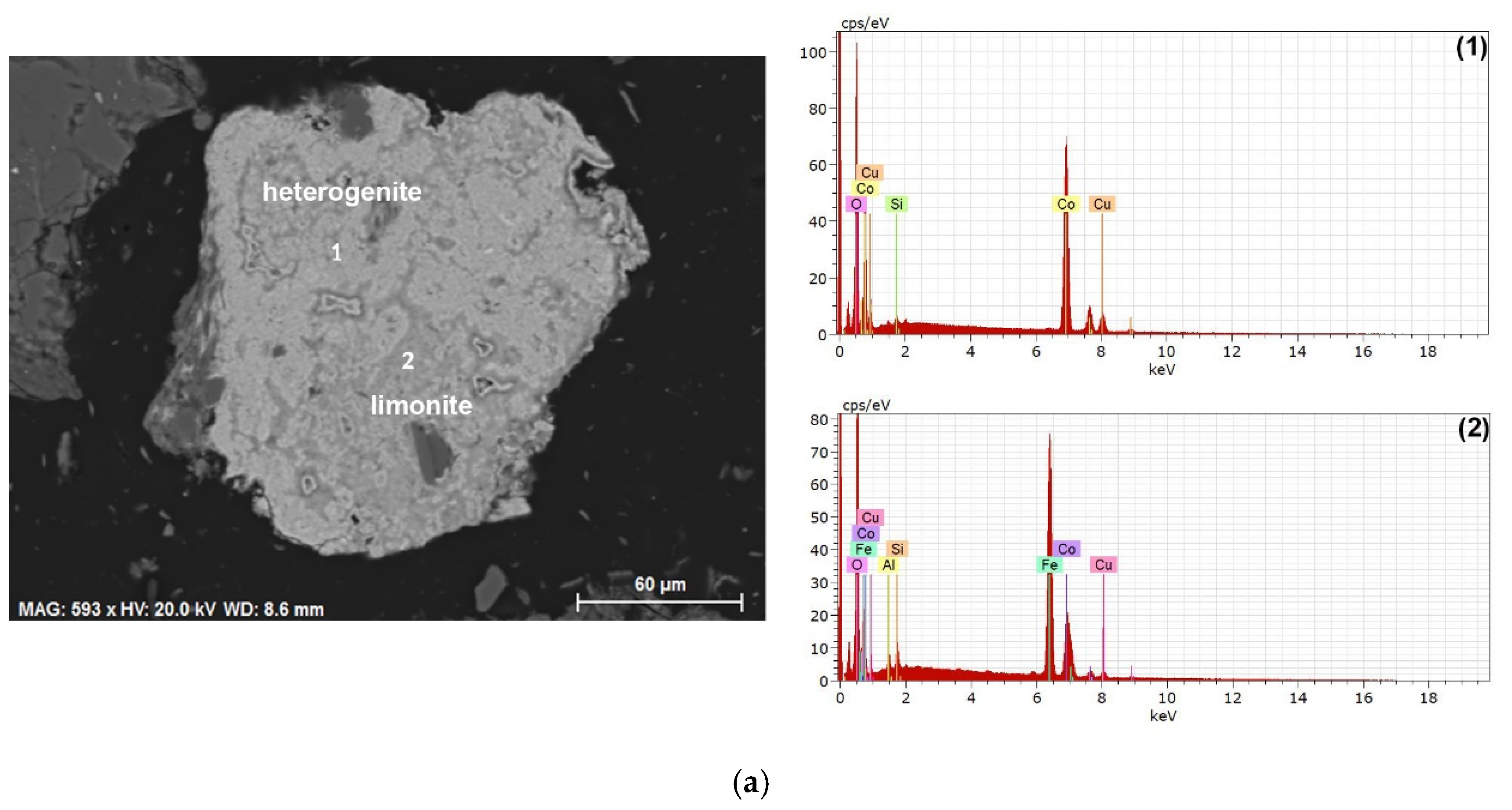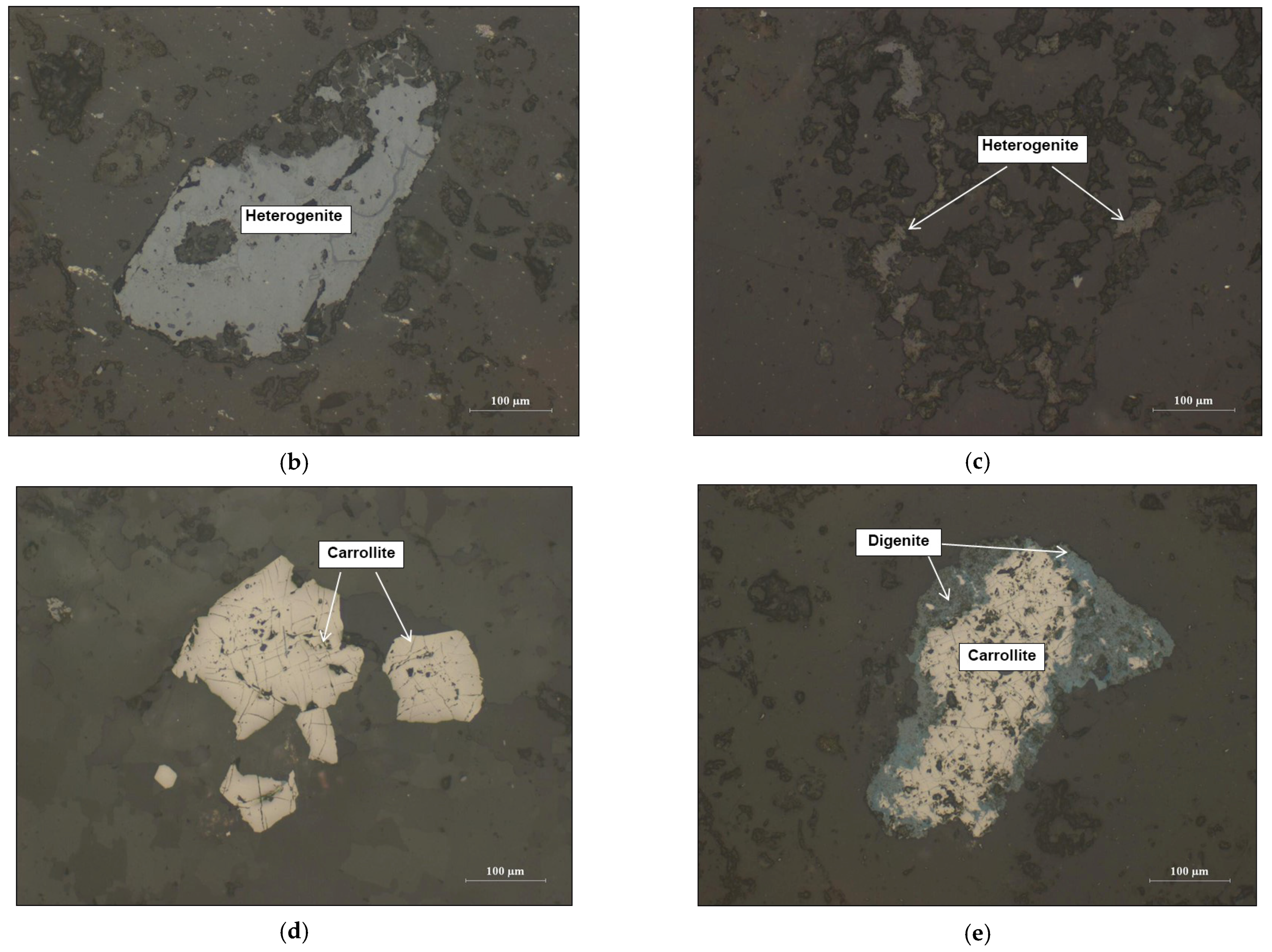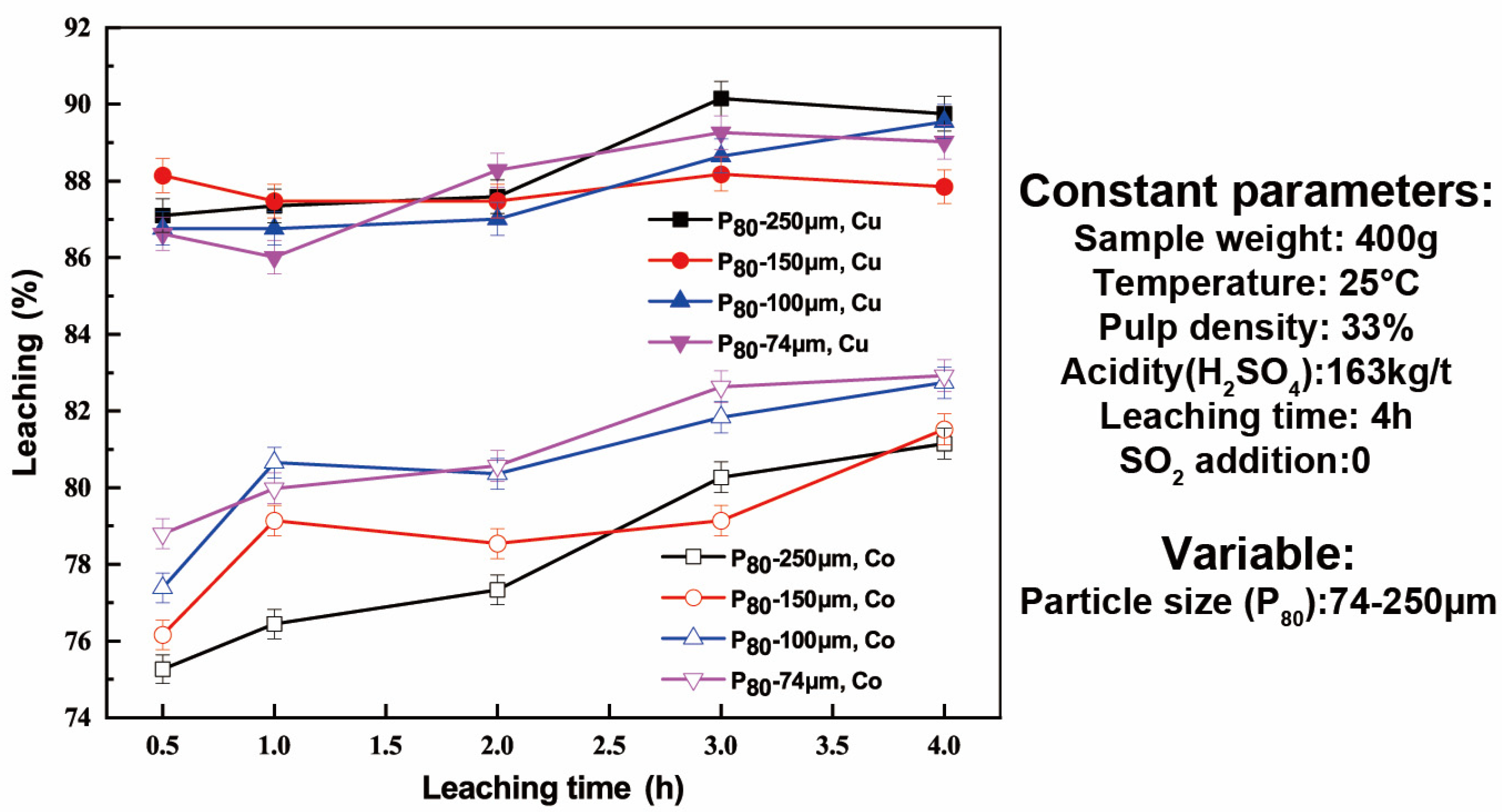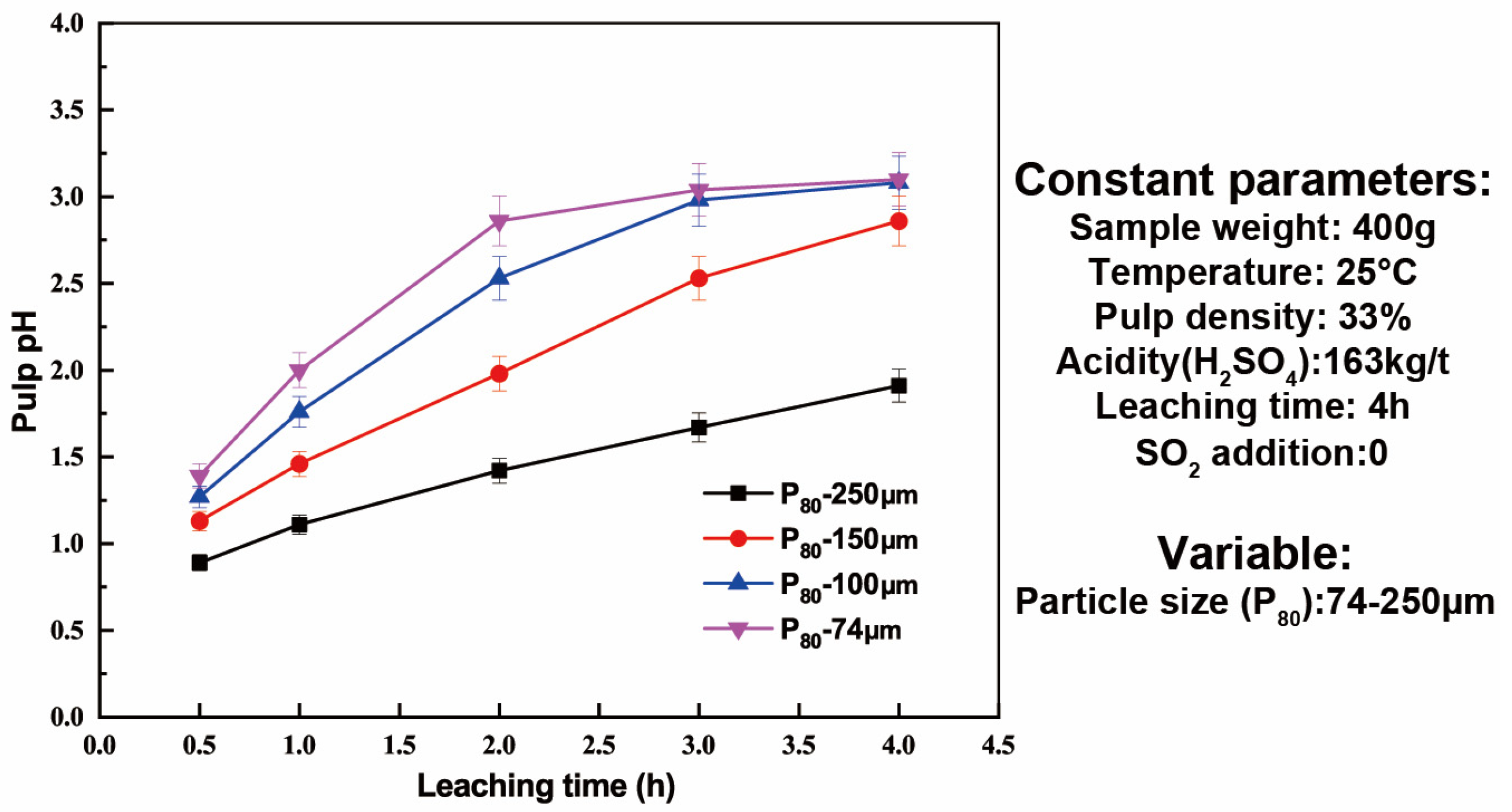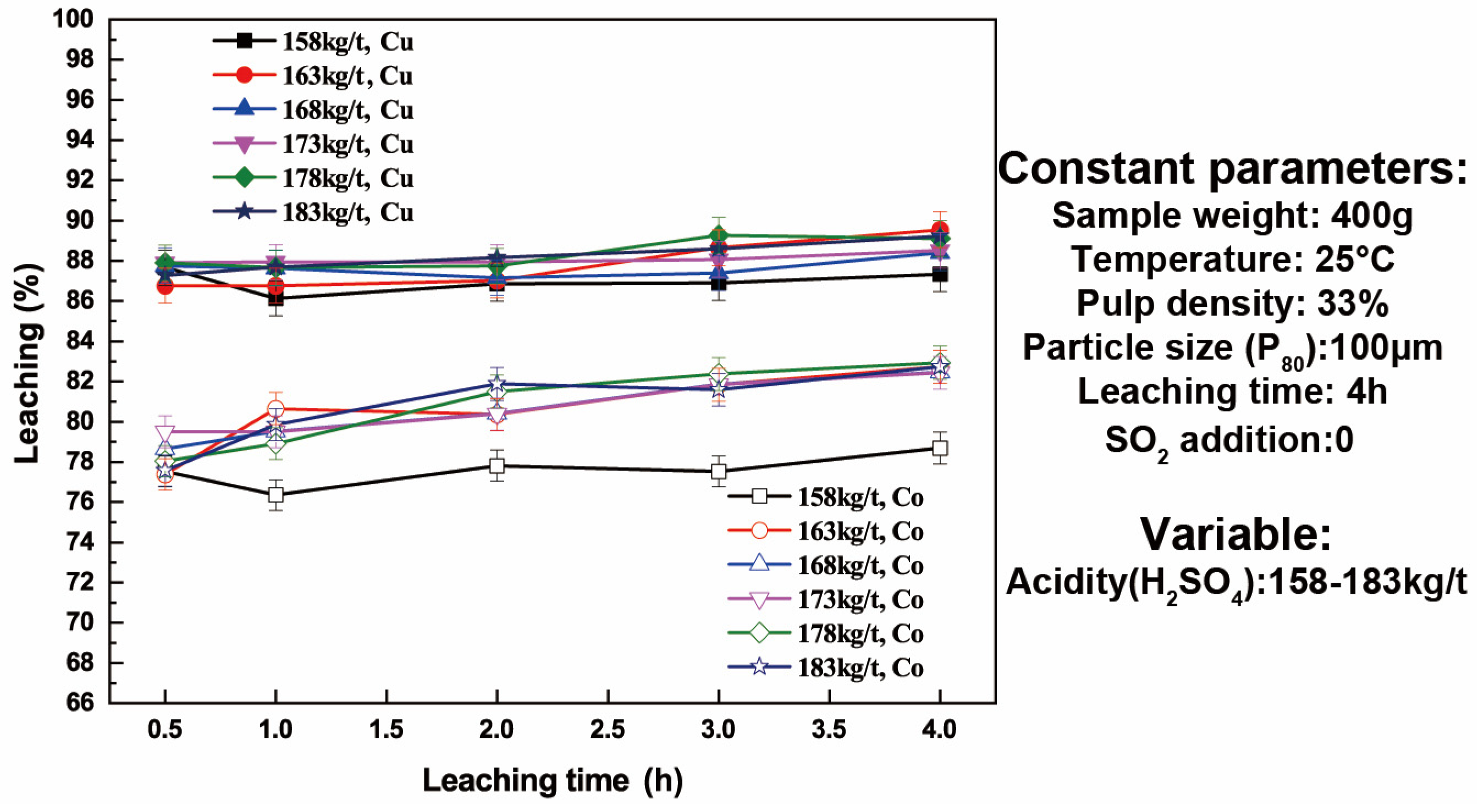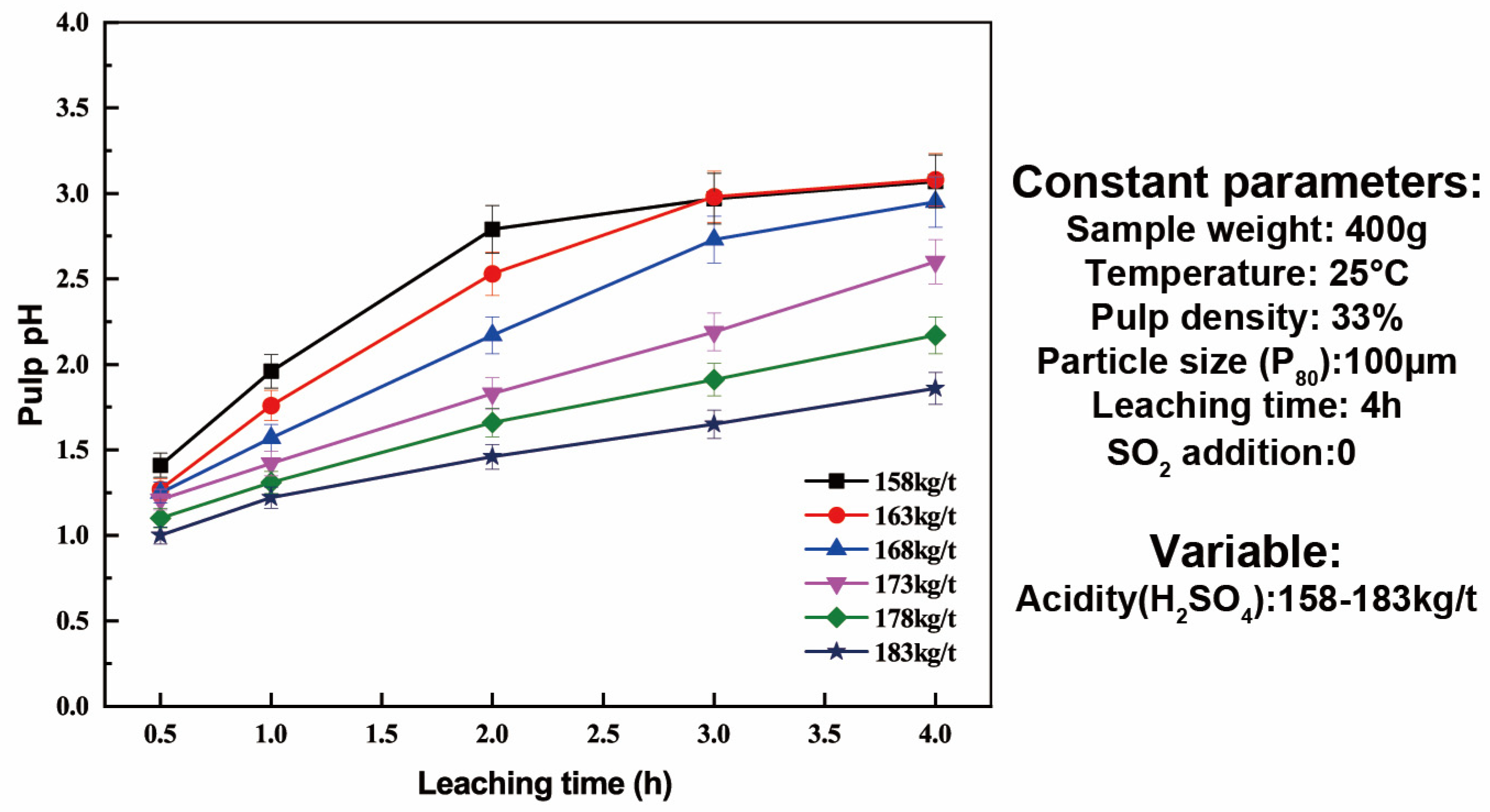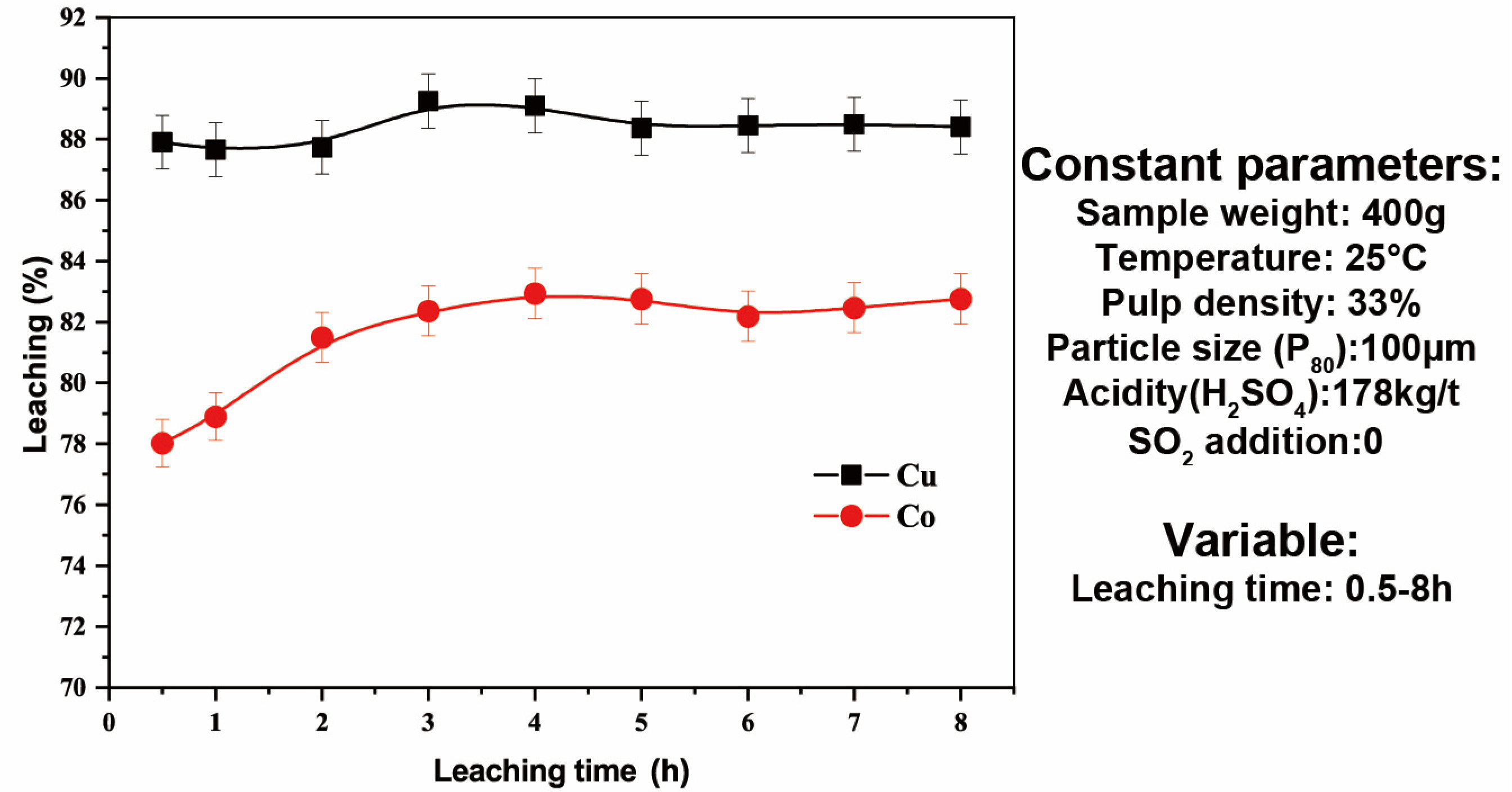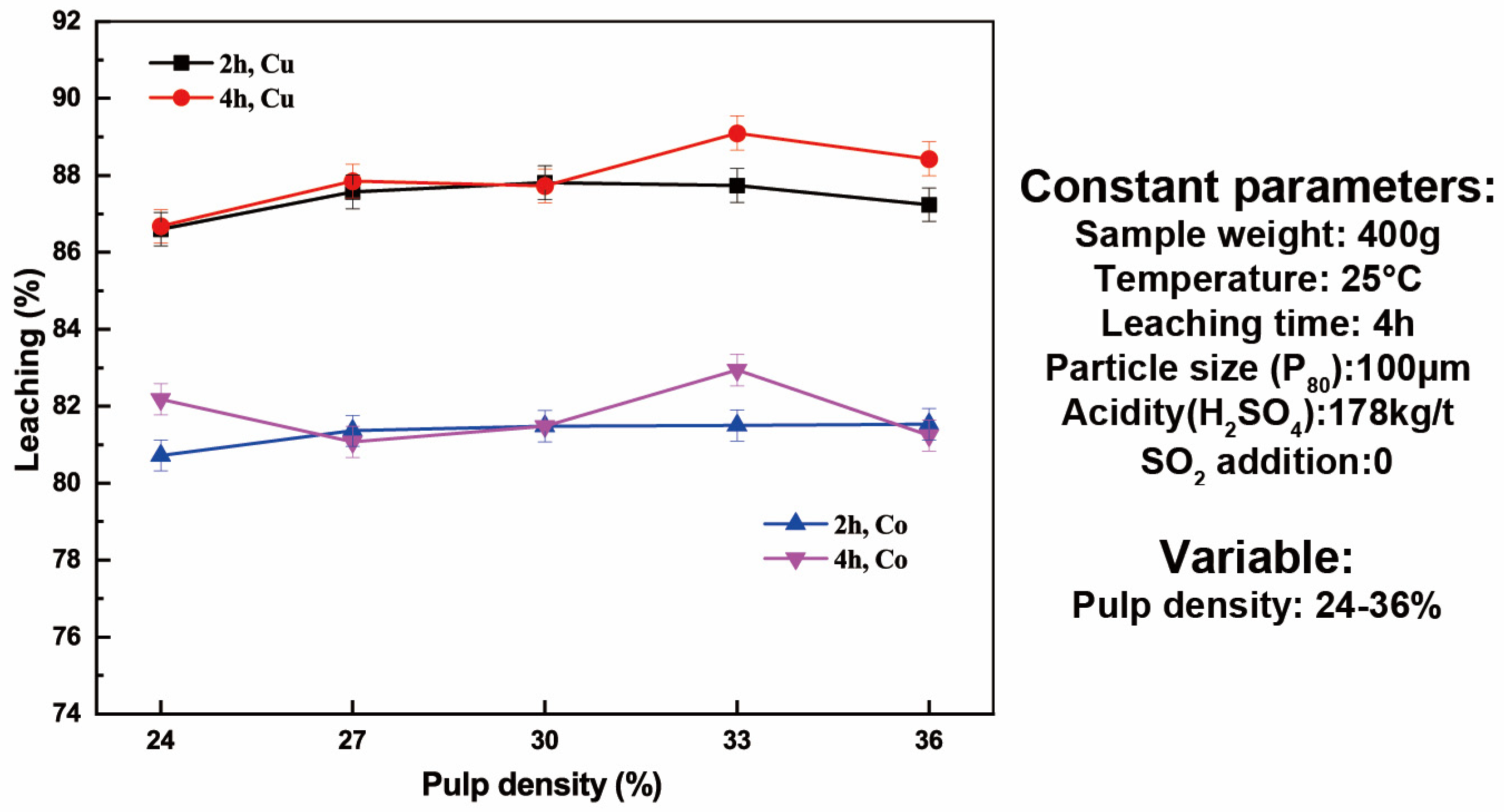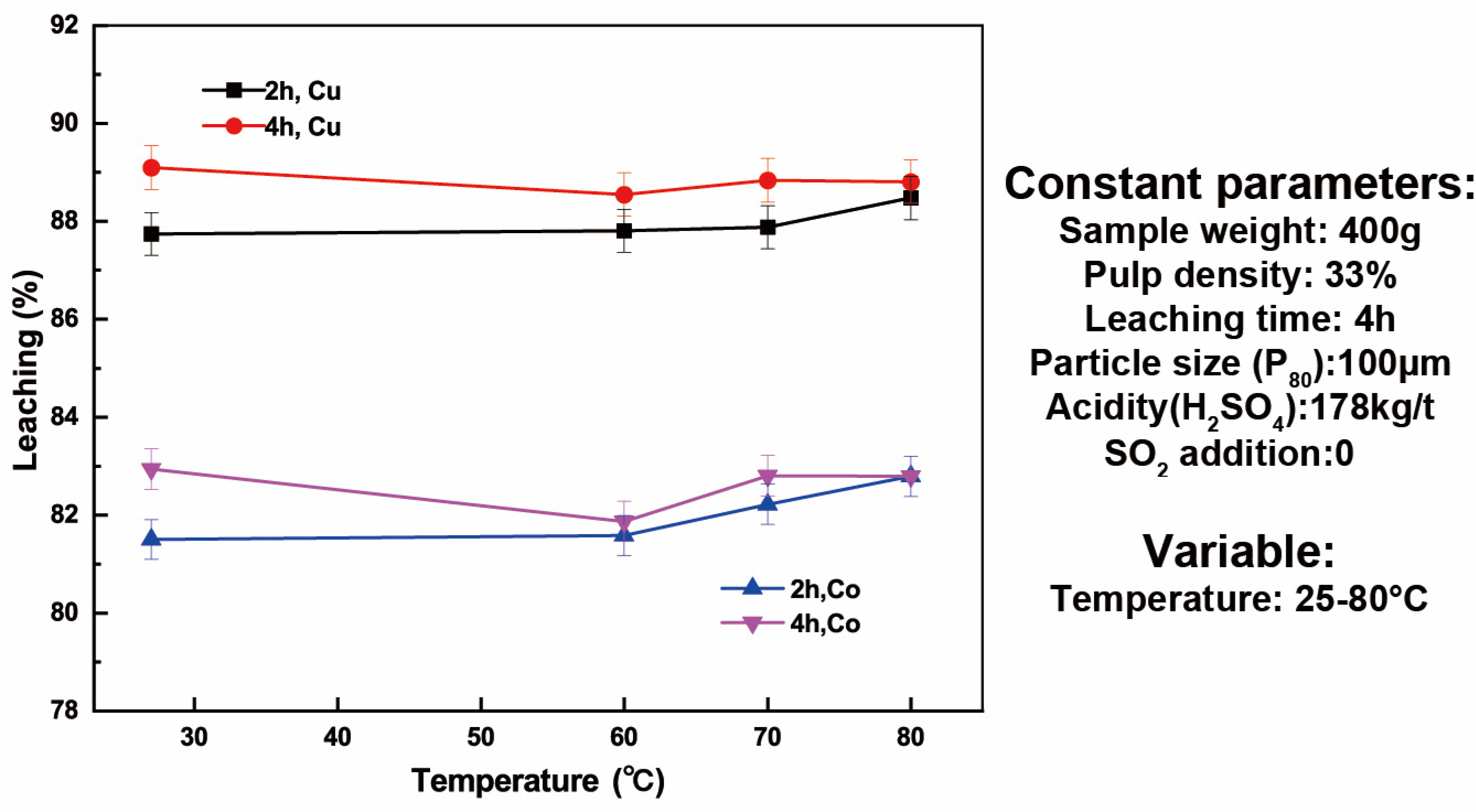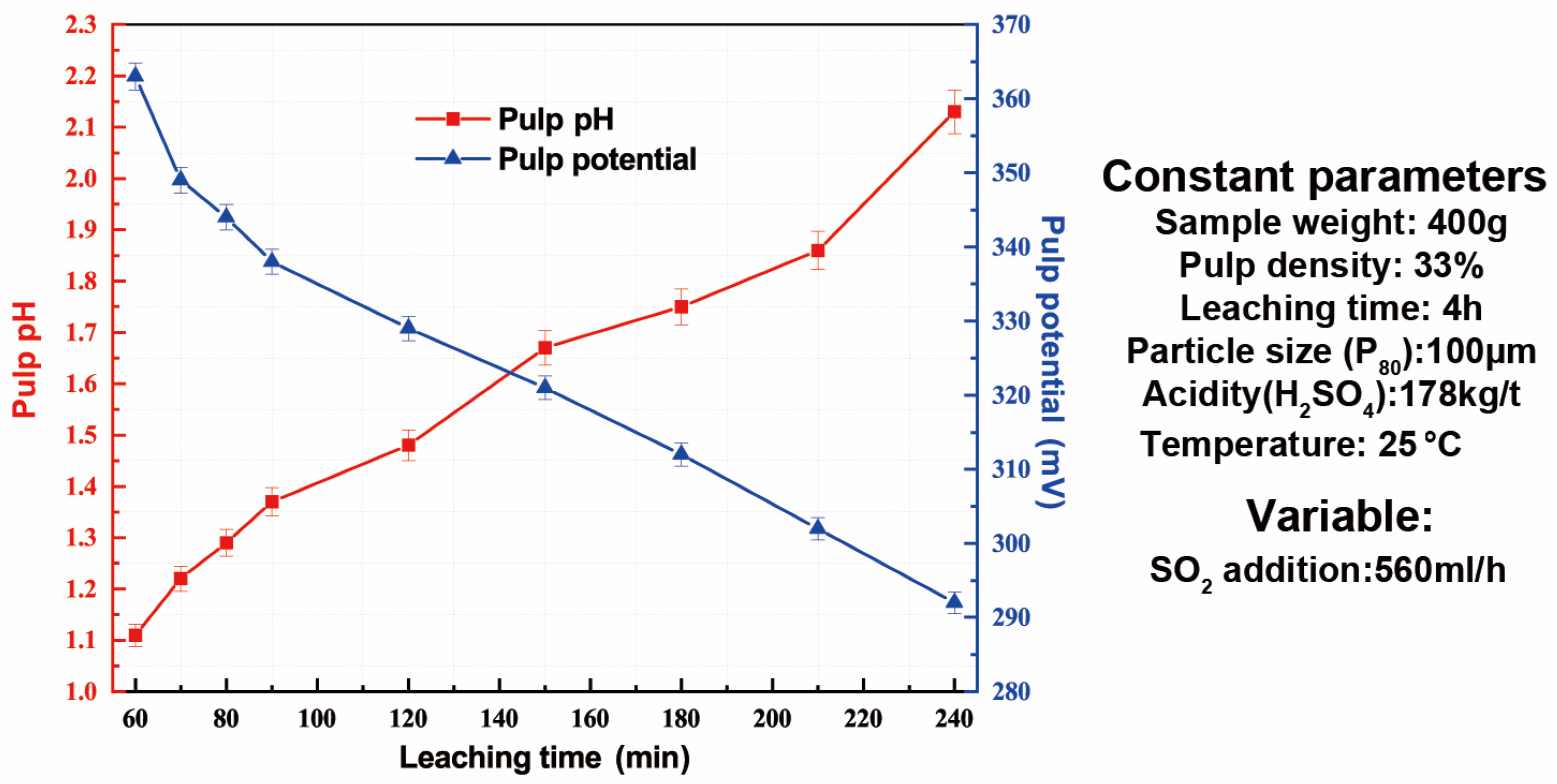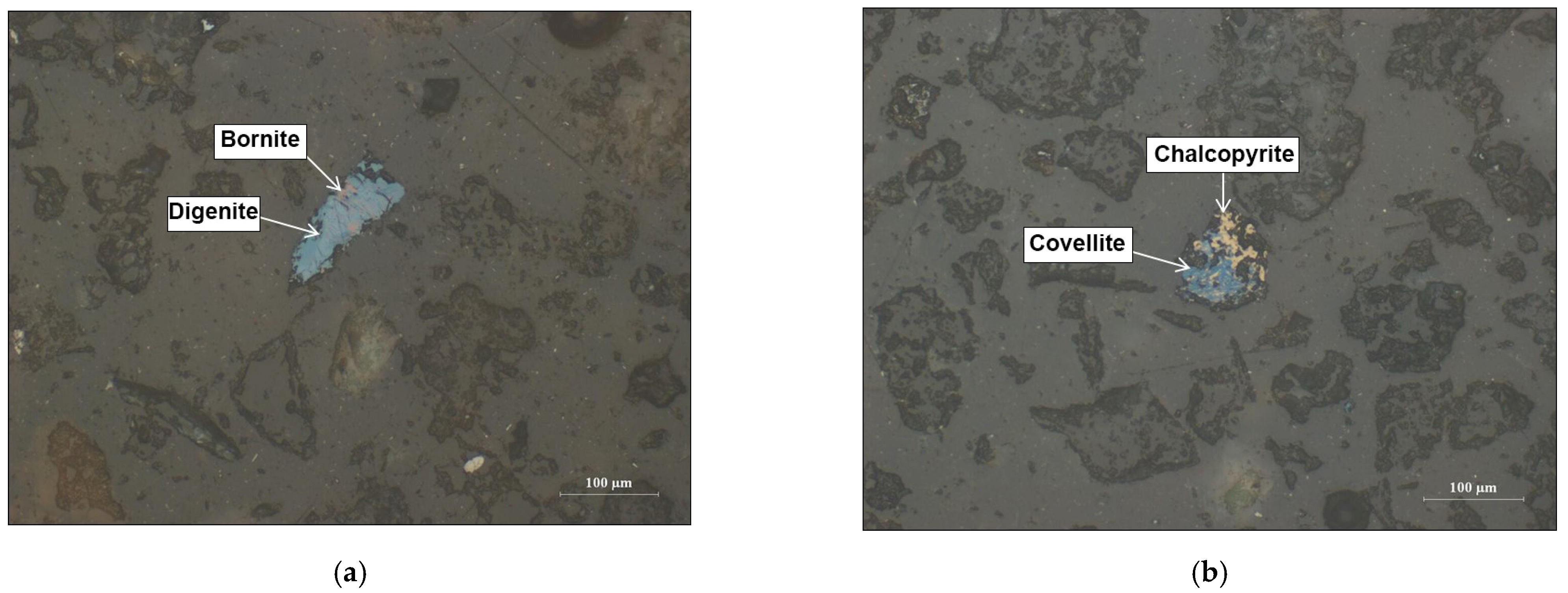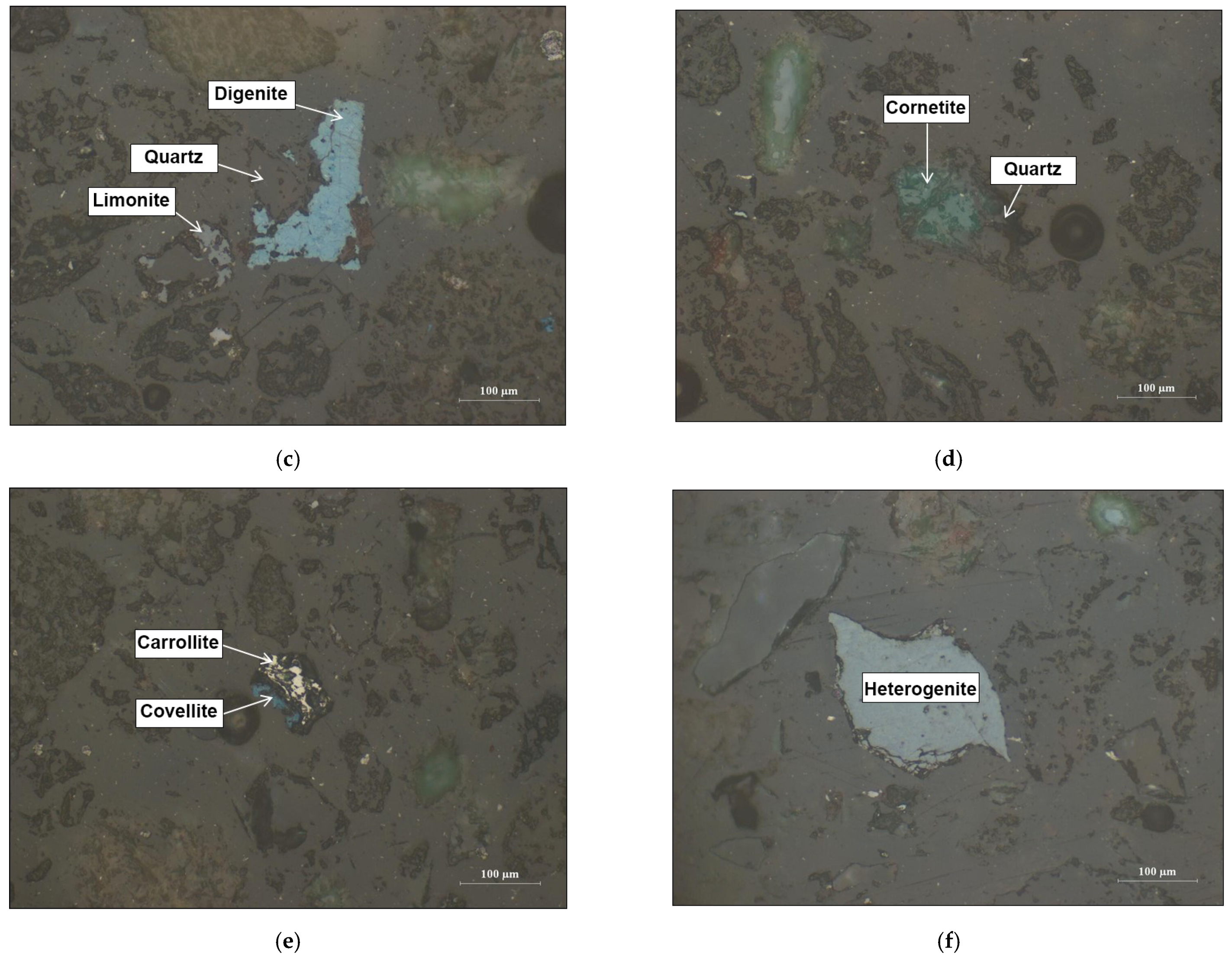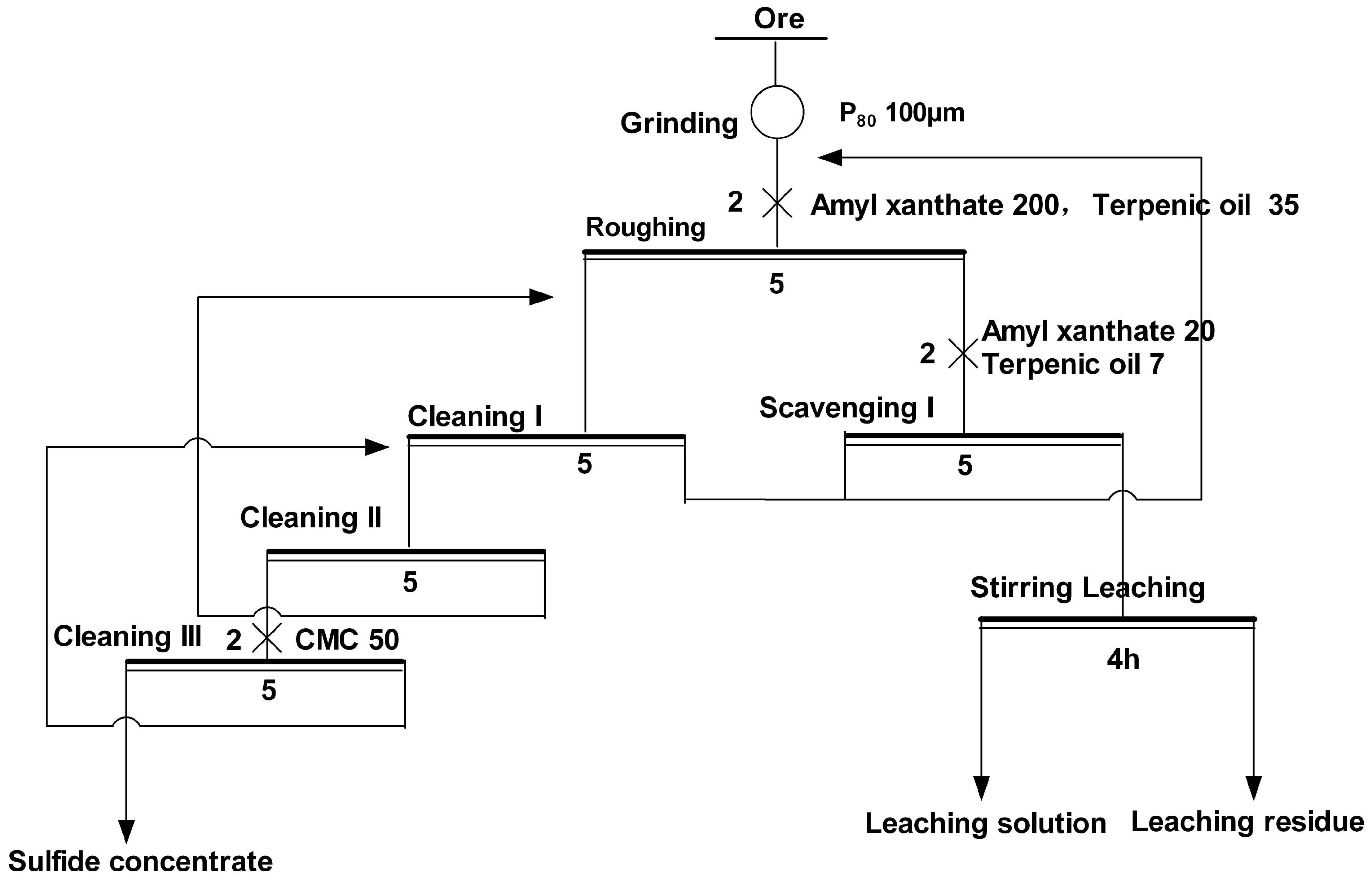3.1. Ore Phase and Composition
The main elemental composition of the ore is shown in
Table 1.
The XRD pattern of the ore is shown in
Figure 2. The main phases contained in the sample include quartz (SiO
2), malachite (Cu
2(OH)
2CO
3), chlorite (Mg
3Si
4O
10(OH)
2), dolomite (CaMg(CO
3)
2), muscovite (K
2O·3Al
2O
3·6SiO
2·2H
2O), and orthoclase (KAlSi
3O
8). The ore was wet sieved to determine the particle size distribution, which showed that the sample has a P
80 of 100 μm.
The process of mineralogy was completed by means of optical microscopy, X-ray diffraction, scanning electron microscopy, and energy dispersive X-ray spectroscopy, combined with chemical analysis, chemical phase analysis, and other means. The complete analysis includes the chemical composition of ores, the mineral composition and relative content of ores, the chemical phase of copper and cobalt, the embedding characteristics of important minerals in ores, the particle size composition and distribution characteristics of copper and cobalt minerals in ores, the dissociation characteristics of copper and cobalt minerals with different grinding fineness, and the occurrence status of copper and cobalt. The copper-bearing minerals in the as-received ore are mainly malachite (including a trace amount of chrysocolla and azurite), accounting for 67.0% of the total copper content, followed by secondary copper sulfide minerals (chalcocite, digenite, and covellite) and cornetite, which account for 9.1% and 7.0% of the copper content, respectively. There is also a small amount of tenorite (3.2%), chalcopyrite (2.6%), bornite (3.1%), carrollite (0.8%), and its natural form (3.1%). Further, 1.8% and 0.7% of copper are distributed in limonite and Fe–Mn hydrated oxide in an adsorption state, and 1.8% of copper is distributed in the form of isomorphism in cobaltite.
Cobalt mainly exists in the form of independent minerals, mainly is in heterogenite (80.4%), and 10.3% exists in carrollite. The remaining cobalt is distributed in Fe–Mn hydrated oxide (4.8%) and limonite (4.5%) in an adsorption state.
The main copper-bearing minerals (malachite, cornetite, chalcocite, and digenite) and cobalt-bearing minerals (heterogenite and carrollite) were also identified using optical microscopy, and the results are presented in
Figure 3 and
Figure 4.
Figure 3 shows that the most important copper-bearing mineral, malachite, is mostly produced as irregular granular and radial aggregates that are mainly distributed in the fissures of quartz and other gangue minerals (
Figure 3b). In addition, the mineral also contains a small amount of chrysocolla and azurite (
Figure 3a), although sometimes malachite and cornetite are found to be co-distributed in the gangue minerals. Cornetite is also an important copper oxide mineral and is mostly produced as irregular grains and aggregates that are mainly distributed in the quartz fractures, with a small amount wrapped in quartz (
Figure 3c). Chalcocite, the most important copper sulfide mineral in the ore, is found to be distributed in the gangue minerals as heteromorphic grains with digenite (
Figure 3d,e), often replacing the positions of bornite and chalcopyrite, and sometimes embedded in a complex manner with carrollite, meaning they are metasomatized along the edge and fissures of carrollite.
Figure 4 shows that heterogenite is mostly produced in heteromorphic crystalline grains and aggregates (
Figure 4b), while a small amount is distributed in gangue minerals in the form of fine veins (
Figure 4c). Sometimes, heterogenite and limonite are cemented in an aggregate, or occasionally they are closely associated with limonite (
Figure 4a). Carrollite, an important cobalt sulfide mineral, is mainly distributed in the gangue minerals, such as dolomite and calcite, in a semi-idiomorphic-heteromorphic granular form (
Figure 4d), with a small amount in idiomorphic structure. Sometimes it can be seen that carrollite is metasomatized by chalcocite and digenite along the edge and the fissure (
Figure 4e), and a small amount coexists with chalcopyrite.
3.2. Leaching Process
During the leaching process, the effects of operating parameters including particle size, acidity, pulp concentration, temperature, leaching time, and reduction potential on leaching efficiency were investigated. The values of each parameter are chosen based on previous experience, as well as industrial application. The parameters were as follows: particle size (P80) ranges from 74 µm to 250 µm; acidity ranges from 158 kg/t to 183 kg/t; pulp concentration ranges from 24% to 36%; temperature ranges from 25–80 °C; leaching time ranges from 0.5–8 h; reduction potential, SO2 is added.
3.2.1. Effect of Particle Size
In general, a fine particle size is beneficial for releasing the valuable minerals locked within gangue minerals, since it promotes the leaching process. However, grinding to a very fine particle size brings about a higher cost and energy requirement. In addition, with further grinding, acid-consuming gangue minerals such as dolomite will also be released, increasing acid consumption. Additionally, any further treatment of the leaching solution requires solvent extraction, which requires an appropriate pH. Thus, good control of particle size during leaching is important. The P
80 of the ore samples ranged from 74 µm to 250 µm, while the weight of the ore tested was 400 g, the temperature was 25 °C, the pulp density was 33%, the acidity was 163 kg/t, and the leaching time was 4 h. The effect of particle size on the extraction of Cu and Co during the leaching process was examined. The test results are shown in
Figure 5.
The test results showed that particle size had no significant effect on the copper leaching rate. However, particle size did affect the cobalt leaching rate. The finer the particle size, the higher the cobalt leaching rate. Copper minerals in general have larger grain sizes than cobalt minerals, and they have more access to acid than cobalt minerals; thus, they were less affected by the change in particle size. For cobalt, with the decrease in particle size, the specific surface area of particles increases, resulting in more rapid reactions with acid. However, very small particle sizes may increase the collision and friction between particles, hindering the diffusion of sulfuric acid at a later stage.
When the particle size changes from a P
80 of 150 µm to a P
80 of 100 µm, the cobalt leaching rate increases from 81.1% to 83.0%, while under the latter condition, the copper leaching percentage reached 89.6% in 4 h. In order to provide an appropriate pH for further treatment such as solvent extraction of the leaching solution, the effect of particle size on pulp pH was also recorded and shown in
Figure 6.
It can be seen that with a decrease in ore particle size, the pulp pH increases, that is, the finer the ore, the higher the acid consumption. Thus, a P80 of 100 µm was selected for follow-up tests, i.e., a compromise between leaching efficiency and acid consumption.
The difference in the leaching behavior of copper and cobalt arises from the trivalent state of cobalt (Co3+) in both sulfide and oxide minerals, which usually has low solubility in aqueous solutions, causing the leaching rate of these minerals to be low. Fine grinding also helps with the leaching of iron from its minerals. In the leaching solution, the reducing species at the particle surface are likely to be ferrous ions in the solution rather than the reductant itself. Therefore, the reductant reduces ferric ions to ferrous ions, and these ferrous ions react at the mineral surface. Thus, the presence of dissolved iron in solution to a certain extent is desirable.
3.2.2. Effect of Sulfuric Acid
The test conditions were set as follows: temperature 25 °C; P
80 100 µm; leaching time 4 h; pulp density 33%. The mass of ore remained constant at 400 g. The initial sulfuric acid mass ratio was 158 kg/t up to 183 kg/t, with an increase of 5 kg/t for each test. The effects of acidity (sulfuric acid mass ratio) on copper and cobalt leaching are shown in
Figure 7.
With an increase in acidity, the copper leaching percentage increases slightly. When the acidity increases from 158 kg/t to 163 kg/t, the cobalt leaching percentage increases, and the cobalt leaching rate shows a slight increase when the acidity is further increased. Under an acidity of 178 kg/t, the maximum recovery of copper and cobalt was 89.3% and 82.9%, respectively.
The effect of acidity on pulp pH was also recorded and shown in
Figure 8. With an increase in acidity, the pulp pH decreases. The further stage of solvent extraction of Cu and Co from the leaching solution usually requires the pH value to be controlled between 1.5 and 2.0 [
23]. Thus, an acidity of 178 kg/t was chosen.
It should be noted that the dissolution of cobalt is always slower than the dissolution of copper. The initial increase in cobalt leaching efficiency is related to the increase in Fe3+ leached into the solution caused by higher acidity. It is further reduced to ferrous ions and acts as a reductant for Co3+ ions. With further increases in acidity, the majority of copper and cobalt from their oxides have been leached. Meanwhile, the formation of jarosite through the hydrolysis of ferric ions is entirely inhibited due to the high acidity. A very high concentration is also unnecessary since hematite re-dissolution may lead to a higher leaching percentage of iron, which causes problems with further treatment.
3.2.3. Effect of Leaching Time
Based on preliminary tests, a leaching time between 0.5 and 8 h was used to determine the effect of leaching time on the extraction behavior of copper and cobalt. The test conditions were P
80 100 µm; pulp density 33%; and acidity 178 kg/t. The weight of the ore was 400 g. The results are shown in
Figure 9.
It can be seen that leaching time has some impact on copper and cobalt leaching efficiency, at least for cobalt, and the leaching reaction of copper–cobalt ore mainly occurs in the first 4 h. Additionally, it should be noted that copper ore leaching is faster, and a higher copper leaching percentage can be obtained in a relatively shorter leaching time. With the extension of the leaching time, the cobalt leaching efficiency increases; however, when the reaction time reaches 4 h, the copper and cobalt leached rates reach a plateau (89.1% and 82.9%, respectively). Thus, the initial leaching time of 4 h was still chosen for subsequent testing.
The leaching kinetics and shrinking core model from past experience explain the lower dissolution rate of cobalt than copper [
4]. The leaching rate was controlled by chemical reactions during the early stages and may be controlled by diffusion in the later stages. Thus, most of the copper and cobalt can be leached out in less than 1 h. The rate becomes much slower when the leaching time is prolonged, where a solid product layer formed by hematite and silica hinders the leaching of minerals, and then the main controlling step becomes the diffusion control of sulfuric acid through the solid product layer formed by hematite and silica. Usually, the chemical reaction-controlled process has a much higher impact than the diffusion-controlled process.
3.2.4. Effect of Pulp Density
Pulp densities of 24%, 27%, 30%, 33%, and 36% (corresponding to a liquid–solid ratio of 3.2, 2.7, 2.3, 2.0, and 1.8, respectively) were tested. The test conditions were a temperature of 25 °C; a P
80 of 100 µm; a leaching time of 4 h; and an acidity of 178 kg/t. Four hundred grams of ore was tested, and the results are shown in
Figure 10. It should be noted, based on the findings reported in
Section 3.2.3, that only the results from leaching times of 2 h and 4 h were analyzed.
It can be seen from the test results that the pulp density did not have a significant effect on the recovery of copper and cobalt. Usually, a lower pulp density can reduce the viscosity of the pulp and the concentration of valuable metal ions in the leaching solution. Thus, it is beneficial for improving the mass transfer rate between the solid and liquid phases, thereby possibly increasing recovery. However, if the pulp density is too small (meaning the liquid–solid ratio is extremely high), the working load of leaching and liquid–solid separation equipment or the loss of the leaching agent will increase. Thus, a value of 33% was chosen since, at this condition, the lowest amounts of copper (0.31%) and cobalt (0.06%) remained in the leaching residue. Under this condition, the copper concentration in the solution can reach approximately 8.90 g/L, and the cobalt concentration reaches 1.08 g/L.
3.2.5. Effect of Temperature
In general, a high temperature is beneficial for increasing molecular activity, which promotes the leaching of minerals. However, as the temperature rises, it could bring a higher cost and operating risk to the equipment. Thus, precise control of the leaching temperature during pressure leaching is always important. The leaching temperature should be as low as possible while ensuring an efficient recovery of copper and cobalt [
18]. The temperature range was 25–80 °C, while the ore tested was 400 g. The remaining test conditions were set as follows: a P
80 of 100 µm; a leaching time of 4 h; an acidity of 178 kg/t; and a pulp density of 33%. The effect of temperature on the extraction of Cu and Co during the leaching process was examined, and the results are shown in
Figure 11.
The test results showed that temperature has little effect on copper and cobalt leaching. However, with an increase in temperature, the difference between the leaching of copper and cobalt under 4 h and 2 h becomes smaller, indicating that the leaching reaction rate increases with an increase in temperature. In addition, the leaching rate of copper and cobalt increased slightly with the prolongation of reaction time, except at 80 °C. To avoid the heating cost, 25 °C (or room temperature) was chosen.
It should also be noted that with an increase in temperature, under high acidity, iron-containing mineral decomposition and leaching dominate, and the iron reports to leaching residues in the form of jarosite. In general, the variation of iron arises from the combination of the leaching of iron-containing minerals and iron hydrolysis precipitation. Under the testing conditions presented here, the hydronium jarosite, formed in a solution with a high Fe
3+ concentration, is highly unstable and usually breaks down to form Fe
2O
3·2SO
3·H
2O, i.e., basic ferric sulfate [
24].
3.2.6. Effect of Reduction Potential
It is known that the potential difference affecting the reaction activation energy and reaction rate is the potential difference between the plane of the compact layer and the surface of the electrode [
25]. Thus, in order to improve the cobalt leaching rate, a reduction in potential tests was performed. The test conditions were set as follows: sample weight 400 g, P
80 100 µm; leaching time 4 h; acidity 178 kg/t; pulp density 33%; temperature 25 °C. SO
2 is introduced with a flow rate of 560 mL/h to control the reduction potential, and the reaction potential is controlled at about 300 mV. At the end of the test, the cobalt leaching increased from 82.9% to 83.3%, which is insignificant. The changes in pulp pH and potential with leaching time are shown in
Figure 12.
It can be seen that during the leaching process, the pulp pH was increasing, and the potential was decreasing. The change in potential does not significantly improve the cobalt leaching, thus, no reductant was added to the test. It should be noted that in some cases if significantly more manganese is present in solution than iron, the required redox potential is higher. With the increase in redox potential comes the increasing possibility of oxidizing cobalt to the trivalent state, Co
3+, which will lead to cobalt losses as a CoOOH precipitate [
26].
3.2.7. Tests Validation
Based on the tests performed, the suggested operating conditions are as follows: P80 100 µm; leaching time 4 h; acidity 178 kg/t; pulp density 33%; temperature 25 °C; no reductant added. Three tests were performed using a 400 g ore for every test. The test results showed that under the suggested conditions, the filtrate pH is approximately 1.90, and 93% of the ore is reported as leaching residue. The copper content of the leaching residue is 0.3%, and the cobalt content is 0.06%. The recovery of copper and cobalt for all three tests reached 88.3% and 82.4%, respectively. In terms of impurity elements, the iron leaching percentage is 6.2%, and the iron content in the filtrate is 0.78 g/L. The calcium leaching percentage is 2.5%, while the magnesium leaching percentage is 30.9%, and the filtrate contains 0.43 g/L calcium and 8.89 g/L magnesium. Further treatment of the solution includes solvent extraction of copper, and after extraction, iron and manganese in the residual solution are removed. After that, cobalt is precipitated before the magnesium is removed since the magnesium leaching percentage is fairly high.
The main element compositions of the leaching residue are shown in
Table 2:
The chemical phase analysis results of copper and cobalt in the leaching residue are also shown in
Table 3.
The phase of the minerals in the leaching residue was also identified by optical microscopy and is shown in
Figure 13. The copper-bearing sulfide minerals such as digenite, chalcocite, chalcopyrite, bornite, and covellite are mainly individual (
Figure 13a,b), some are associated with gangue minerals (
Figure 13c), and a few are associated with chalcopyrite and pyrite, the embedded grain size of those minerals is generally between 75 and 100 µm. Cornetite is mainly a monomer (
Figure 13d), and the embedded particle size is generally between 20 and 150 µm. While for cobalt-bearing minerals, the carrollite partially exists in the form of monomers, and partially is associated with digenite, covellite, and gangue minerals (
Figure 13e), with an embedded particle size of 20–75 µm. Heterogenite mainly exists in individual form (
Figure 13f), and the embedded particle size is generally between 20 and 75 µm.
3.2.8. Analysis of Copper-Bearing Minerals during Leaching
As can be seen from
Table 3, the copper oxide phase leaching efficiency is 98.3%, with only a small amount of malachite and cornetite not being leached. Malachite is found to be occasionally locked within or embedded by gangue minerals (
Figure 13d). The leaching of natural copper is also high (97.4%), despite it being difficult to leach under low acid and atmospheric leaching conditions. This could be because acid consumption is quite high during the process. In the leaching process, under local high acid and exothermic conditions, the following reactions may occur [
27,
28]:
The leaching of secondary copper sulfide reached 61.7%. The main secondary sulfide mineral is chalcocite, but rather than chalcocite, only digenite is found in the residue. Chalcocite can undergo the following reactions:
If the reaction is incomplete, the following reaction may occur to generate digenite:
A small part of the chalcocite may undergo the following reactions under local high acid and exothermic conditions [
29]:
The copper in the primary copper sulfide minerals, and Fe–Mn hydrated oxides, is hardly leached. It can also be seen from
Table 3 that some copper is contained in other minerals in the leaching residue; with 10.8% in the residue. This copper cannot be leached under the enhanced leaching conditions. It may be coated by very fine and dense calcium sulfate, or by a copper sulfide such as digenite. To conclude, in addition to the copper oxide, natural copper and more than half of the secondary copper sulfide are also leached, making the copper leaching rate higher than the copper oxidation rate.
3.2.9. Analysis of Cobalt-Bearing Minerals during Leaching
It can be seen from
Table 3 that the leaching efficiency of the cobalt oxide phase is 99.3%, which is almost completely leached, mainly existing as heterogenite. The valence state of cobalt in heterogenite (CoO(OH)
x) is partially divalent and partially trivalent. During the leaching process, bivalent cobalt is easily leached by sulfuric acid to form cobalt sulfate, while trivalent cobalt needs to be leached using a reductant. Because there is a high proportion of secondary copper sulfide minerals, such as chalcocite, in the ore, chalcocite acts as a reducing agent in the leaching process. The following reactions may occur during this process [
4,
30]:
The content of copper in the chalcocite of the raw ore is 0.26%, which is enough to complete the leaching of trivalent cobalt during the process. Thus, in stirred leaching, the pulp already has a very strong reduction potential due to the existence of chalcocite, which consequently explains why adding SO2 as a reductant does not increase cobalt leaching.
The cobalt sulfide is mainly carrollite, which can be partially leached under high acid and exothermic conditions. Cobalt in Fe–Mn hydrated oxide is difficult to leach. Some cobalt is also found in other minerals in the leaching residue, with 30.4% of the cobalt remaining in the residue. This cobalt may be coated with very fine and dense calcium sulfate and is mainly carrollite. Additionally, it was found that the cobalt grade of the coarse part of leached residue (250 µm) was 0.13%, which was much higher than that of other finer parts. This may be because the cobalt in the coarser particles cannot be fully leached under the current conditions.
The explanation for the possible coating behavior of copper, and cobalt minerals by CaSO4 may be illustrated as follows: for copper and divalent cobalt (Co2+), according to the shrinking core model, the initial reaction between those minerals and acid is mainly controlled by chemical reactions. Those chemical reactions are fast. Then, over time, those minerals gradually shrink to a smaller size. At some point, the viscous calcium sulfate generated will cover the surface of those unreacted minerals, and these minerals will form crystal nuclei for calcium sulfate, which will help calcium sulfate undergo crystallization. Thus, the thickness of the calcium sulfate gradually increases, further making solid layer diffusion more difficult for those minerals. While for trivalent cobalt (Co3+), there are two possibilities: first, as the reaction proceeds, it reacts with reducing minerals such as chalcocite, and the formed CoSO4 will not be encapsulated by calcium sulfate; however, some remaining portions of trivalent cobalt minerals that have shrunk in size may still be encapsulated by calcium sulfate as explained above. The sulfuric acid consumption from the tests corresponds to the consumption calculated.
3.3. Combination of Flotation and Acid Leaching
As indicated previously, the main mineralogical factors affecting the leaching of copper and cobalt mainly include the following aspects:
A 14.7% portion of copper exists in the form of sulfide minerals, including chalcocite, digenite, chalcopyrite, bornite, and covellite, while 10.3% of cobalt exists in the form of carrollite. The leaching of those sulfide minerals under current acid leaching conditions is slow and has proven to be incomplete.
A 2.5% copper portion and a 9.3% cobalt portion are, respectively, distributed in limonite and Fe–Mn hydrated oxide in an adsorption state, which are also difficult to leach. In addition, 3.1% of copper is found as natural copper, which is also a problem.
The ore contains a large number of clay minerals, namely, 13.9% muscovite and 17.4% chlorite. These clay minerals easily form mud, which will harm the leaching. Most operations targeting oxide ores do not have the roasting step and hence lose the sulfide fraction. Those targeting the sulfide ores only partially recover oxide cobalt (flotation and roasting).
Thus, the process of combining flotation and flotation tail acid leaching may be considered to achieve better copper and cobalt recovery [
31]. In this way, copper and cobalt sulfide minerals in the ore can be effectively recovered. However, there are also mineralogical factors affecting the flotation recovery, which include the following aspects: Some of the non-leached minerals have relatively fine grain sizes and are mainly disseminated within gangue minerals, which affects the effectiveness of flotation recovery; the composition of copper oxide minerals is relatively complex; thus, it is very difficult to select appropriate reagents for flotation. The copper and cobalt distributed in limonite and Fe–Mn hydrated oxide in the adsorption state are also difficult to recover through flotation; clay minerals need to be inhibited in the flotation process.
Ore beneficiation processing is the process of separating useful minerals from gangue minerals or separating various useful minerals using various methods such as gravity, magnetism, flotation, and electricity based on the differences in physical and chemical properties of different minerals in the ore. Beneficiation can enrich useful minerals and significantly reduce the production costs of subsequent processes, such as metallurgy, chemical engineering, and material preparation. The beneficiation process mainly includes sample preparation, beneficiation separation, material dehydration, etc. The specific mineral separation method used for a specific ore needs to be determined through detailed mineral processing experiments. As for copper–cobalt ore, flotation or a combination of flotation and magnetic processes is currently commonly used for improving recovery. The beneficiation experiments of copper–cobalt ore generally include research on ore properties, copper–cobalt sulfide flotation experiments, copper–cobalt oxide flotation experiments, and high-intensity magnetic separation experiments.
For the flotation process in our study, one roughing stage, three cleaning stages, and one scavenging stage were involved. The ore was first ground to give a P
80 of 100 μm, while amyl xanthate was used as a collector and Terpenic oil was used as a frother. The sulfide concentrate obtained from the roughing stage goes through three cleaning stages, and the tailings from each cleaning stage will be recycled, whereas the tailings obtained from the roughing stage report to the scavenging process and further go through agitation leaching to recover the valuable metals from oxide minerals. The process schematic is shown in
Figure 14. It should be noted that all numbers during stages of flotation have a unit of minutes, and all numbers after flotation reagents have a unit of g/t.
The flotation results are shown in
Table 4:
It can be seen that the sulfide concentrate contains 35.2% copper and 2.9% cobalt, while the recovery of copper and cobalt is 20.3% and 12.0%, respectively. To recover the remaining copper and cobalt, it was leached under the conditions of a temperature of 25 °C; a pulp density of 33%; an acidity of 178 kg/t; and a leaching time of 4 h. The stirred leaching results of flotation tailings are shown in
Table 5.
The copper leaching efficiency of sulfide ore flotation tailings is approximately 95%, and the cobalt leaching efficiency is only 45.3% without the addition of a reducing agent. The cobalt leaching increases drastically with the addition of a reducing agent (Na2SO3) to reach 84.0%. This is because secondary sulfide minerals, including chalcocite, are selected during flotation, and no component can act as a reducing agent for the stirred leaching process. Therefore, a small amount of reducing agent needs to be added.
Based on the condition above, the combined recovery of copper and cobalt is calculated to be 96.6% and 86.0%, respectively, assuming the Cu and the Co are recovered/leachable at 100%. When compared with direct stirred leaching, copper recovery increased by 8.3% and cobalt recovery increased by 3.6%, meaning that the combination of flotation and acid leaching is effective. With mining continuing to greater depths, the advantages of the combination of flotation and acid leaching will be more obvious due to the increase in sulfide ore mineral content.
When compared with peer work focusing on routine leaching tests [
32,
33], this study proposed the oxidation-reduction reaction between high valent cobalt and chalcocite, bringing the possibility of efficient cobalt leaching by blending of oxidized ore and reduced ore without the addition of regular SO
2 or Na
2S
2O
5. In addition, it explored the mechanism of calcium sulfate encapsulation of unreacted minerals and crystallization through unreacted minerals as crystal nuclei. Furthermore, a combination of beneficiation and hydrometallurgy to deal with complex copper–cobalt ores and improve metal leaching efficiency was discussed, as was the leaching behavior and influence of iron through the leaching process.
